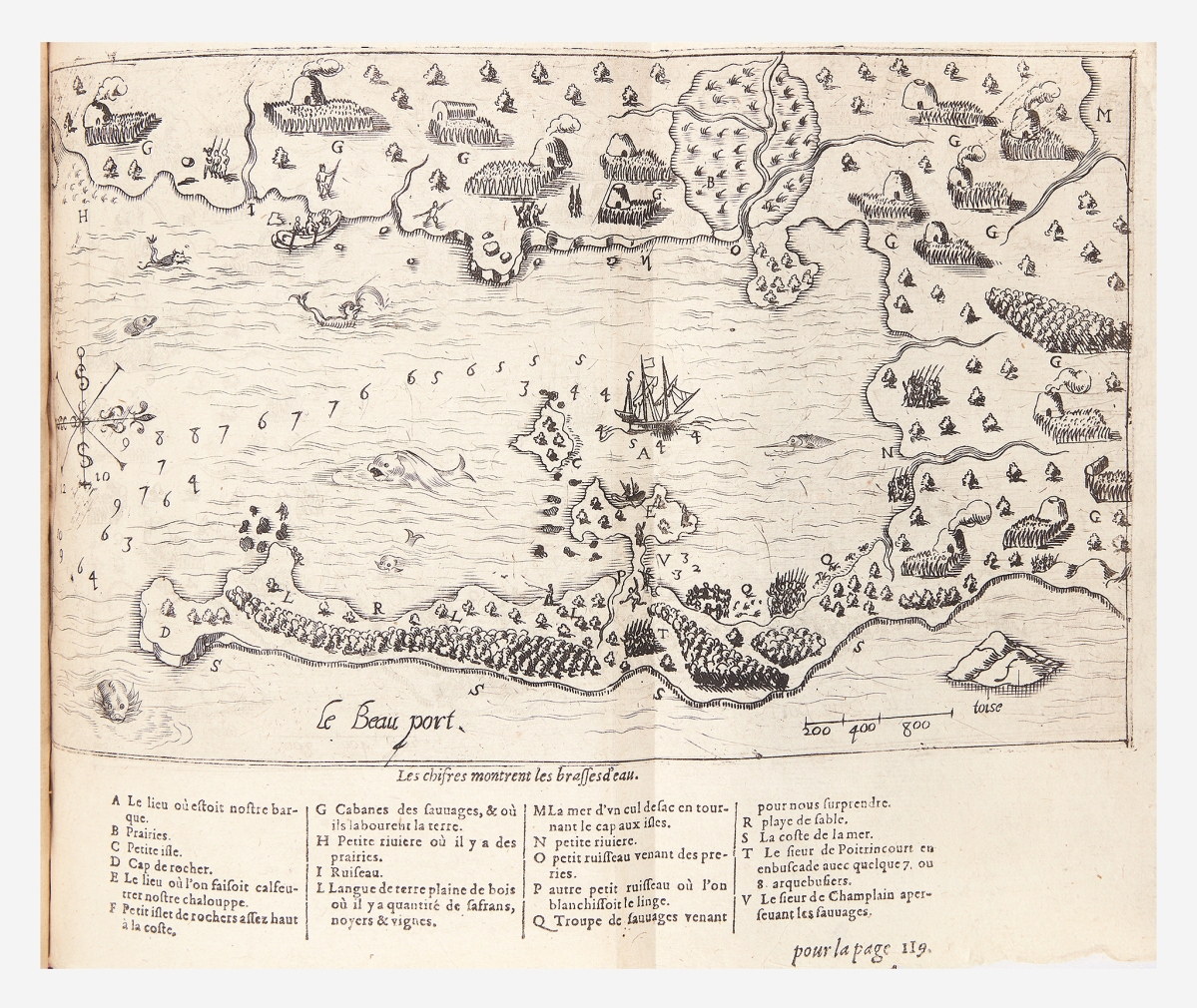
A first edition of French explorer Samuel de Champlain’s second book, Les Voyages du Sieur de Champlain, Paris, 1613, sailed to a final price of $201,600 against a $40/60,000 estimate, the top lot in the sale.
Review by W.A. Demers, Photos Courtesy Freeman’s
PHILADELPHIA – A first edition of French explorer Samuel de Champlain’s second book, Les Voyages du Sieur de Champlain, Paris, 1613, sailed to a final price of $201,600 against a $40/60,000 expectation, the top lot at Freeman’s books and manuscripts auction on February 18. There were 166 lots in the sale, a broad selection of literature greats, photographs, prints, early documents, children’s books, counter-culture and more, all offered under the direction of the firm’s department head Darren Winston. The sale totaled $445,197 with a 91 percent sell-through rate. There were 694 registered bidders representing 21 countries vying on four online platforms, plus telephone.
“I was very pleased, surprised in some instances,” said Winston following the sale. “You never know what’s going to happen. Every title, every book you take in, you think is great and you want it to do great, when suddenly there’s 167 of them. They’re going to get in line. You just can’t predict.”
Two parts in one, the Champlain book was illustrated with three engraved folding plates, eight engraved folding maps, 13 in-text engravings and one woodcut diagram. Containing the journals, maps, etc., of its author’s four voyages to America, in 1604, 1610, 1611 and 1613, the volume deals very fully with the natural history of the country, its soil and products, and is especially minute in its description of the manners, customs and habits of the Indians. Samuel de Champlain was the single most important factor in the initial success of French attempts at gaining a foothold in America. He spent the majority of his life in New France and devoted considerable energy to its success. He crossed the Atlantic more than 20 times, going back and forth to encourage and maintain support for the venture.
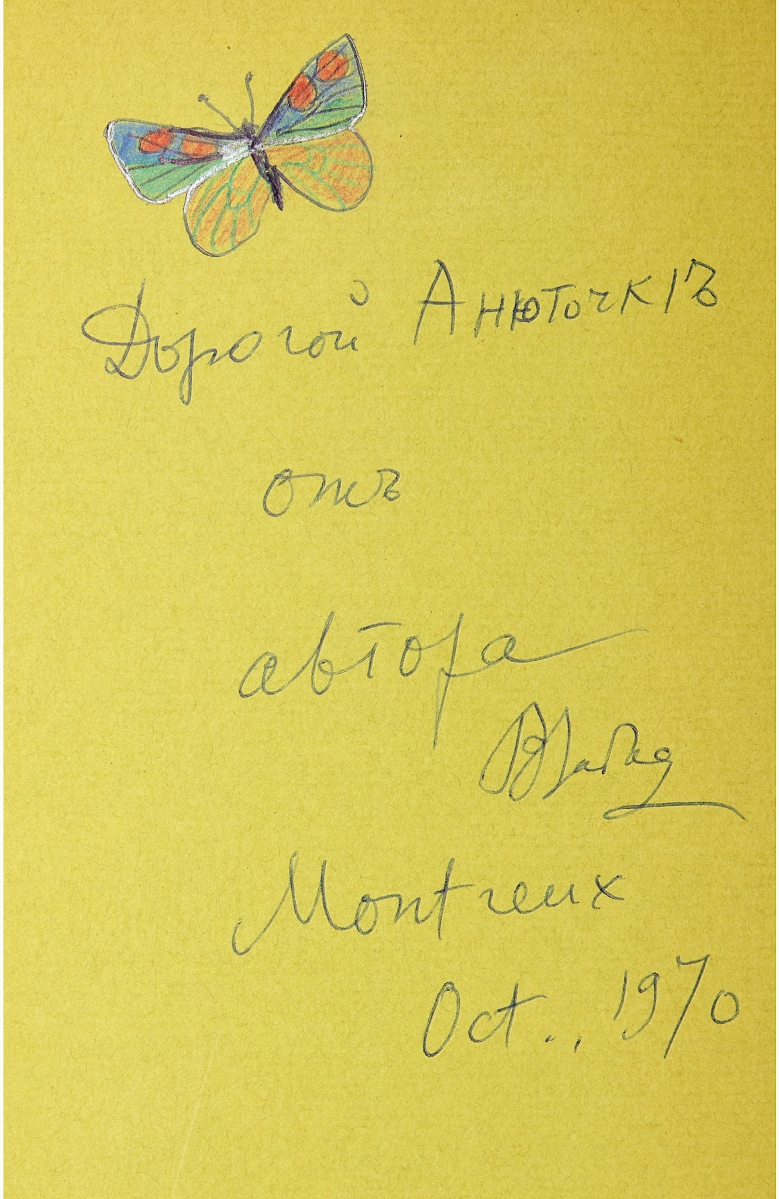
Close friends and relatives of novelist Vladimir Nabokov (1899-1977) would get butterfly drawings in books inscribed to them. This first edition of Ada or Ardor: A Family Chronicle sold for $15,120, more than double its high estimate. Published in London by Weidenfeld and Nicolson in 1969, this was a presentation copy, signed and inscribed with a butterfly drawing to his wife Vera’s close cousin, Anya Feigin, dated October 1970.
“The book came from a previous consignor of ours,” said Winston. “I got an email with some photos – 10 or 12 things – and there was a photo of the binding and the front cover. It was the tooling that jumped out at me, just very well done, like you can spot the cut of a good suit from a block away. And I believe there were some details in the text, so I responded, ‘Can I come out and look at the stuff, we can talk. I went to their home, they couldn’t have been nicer. We went through their stuff and I found out that the book had been given to the consignor’s father as a gift in the 1940s and had been in the family for the past 80 odd years.”
Winston said that the book went to the trade on the phone, unclear whether it was purchased for stock or bought on behalf of a private client.
A literature highlight, Vladimir Nabokov’s (1899-1977) Ada or Ardor: A Family Chronicle sold for $15,120, more than double its high estimate. Published in London by Weidenfeld and Nicolson in 1969, this first English edition was a presentation copy, signed and inscribed with a butterfly drawing to his wife Vera’s close cousin, Anya Feigin, dated October 1970. Nabokov, author of Lolita, was an accomplished lepidopterist, in fact becoming a volunteer entomologist at the American Museum of Natural History when he and his wife moved to Manhattan. He would include butterfly drawings in books inscribed to those especially important to him. The closer the connection, the more elaborate the drawing. The Nabokovs, after their exile from the Soviet Union, moved in with Anya in Berlin. Later, after her husband’s death, Anya lived alone in New York City, but due to her deteriorating health, Vera had her flown to their home in Montreaux, Switzerland, to ensure that she was cared for. The Nabokovs set her up in a home near their apartment in the Palace Hotel, and for the remaining 18 months of her life they visited her multiple times a week.
Soaring to nearly five times its high estimate at $13,100 on 41 bids was a large folding board game. Thomas Birch and J.H. Seymour collaborated on The Geographical Pastime, or the Complete Tour of Europe, published in Philadelphia by E. Parker in 1822. Comprising eight hand colored engraved panels, including one large hand colored cartouche, top left panel and mounted to linen, it was one of the earliest board games published in the United States. The players’ goal was to traverse Europe, Russia and parts of North Africa, along 138 stopping points on their Grand Tour, starting in Dover, England, and finishing in London. There is only one recorded copy of the game in the Library of Congress, Washington, DC. Winston said the underbidder was a games collector, with it ultimately going to a private buyer.
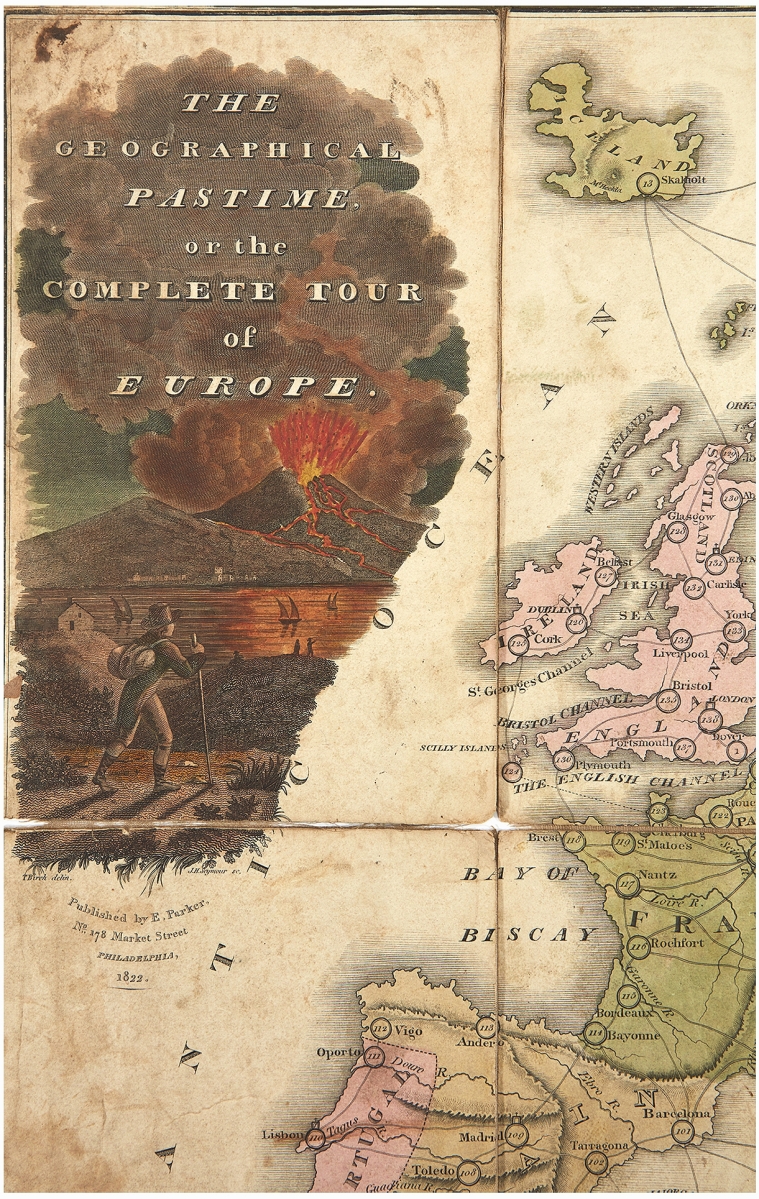
There is only one recorded copy of this game in the Library of Congress, Washington, DC. Thomas Birch and J.H. Seymour’s large folding board game, The Geographical Pastime, or the Complete Tour of Europe, published in Philadelphia by E. Parker in 1822, soared to five times its high estimate at $13,100 on 41 bids.
Another high-flying item in the games category was a complete deck of 52 chromolithograph transformation Harlequin playing cards, New York, Paris, London: Tiffany & Co., 1879, in their original printed box by Charles E. Carryl (1841-1920), an American children’s literature author who at the end of the Nineteenth Century was hailed as the American Lewis Carroll. Bid to $8,820, five times the high estimate, the cards appear never to have been played with, all of their edges gilt and corners square; no wear of any kind. This set is widely regarded as the most artistic and skillful American transformation deck, cards on which the pips are incorporated into an artful scene rather than standing alone on a white background.
Then there was Edward Wallis’ Locomotive Game of Railroad Adventures. Undated but circa 1840s, the large folding game comprised 15 hand colored aquatint panels that were mounted to linen. Anticipating perhaps the classic game of Chutes & Ladders, this forward-backward locomotive-themed game, produced during the height of the railroad boom in the Nineteenth Century, had players traversing the board, stopping at different stations and locales, with dangers and fortune at every turn. A compelling mashup of the era’s revolutionary technology and the ever-present human need for fun, the 9-5/8-by-24-inch sheet mounted to a red and black striped cloth-covered folder pulled in at $5,355.
Photography was included in this sale, and a circa 1962 gelatin silver print by Ansel Adams (1902-1984), “Evening Clouds, East Side of the Sierra Nevada, California,” was bid to $10,710. It was signed by Adams on the bottom right, with a studio stamp on verso. The 15¾-by-19½-inch image was mounted to board, toned and framed, and had once been in the collection of Dr Edwin H. Land. If that name sounds familiar, Land was an American scientist and inventor, best known as the co-founder of the Polaroid Corporation. Another Adams, also from the Land collection, was “Timber Cove, Northern California Coast,” circa 1960, a tempestuous scene that found a buyer at $4,410.
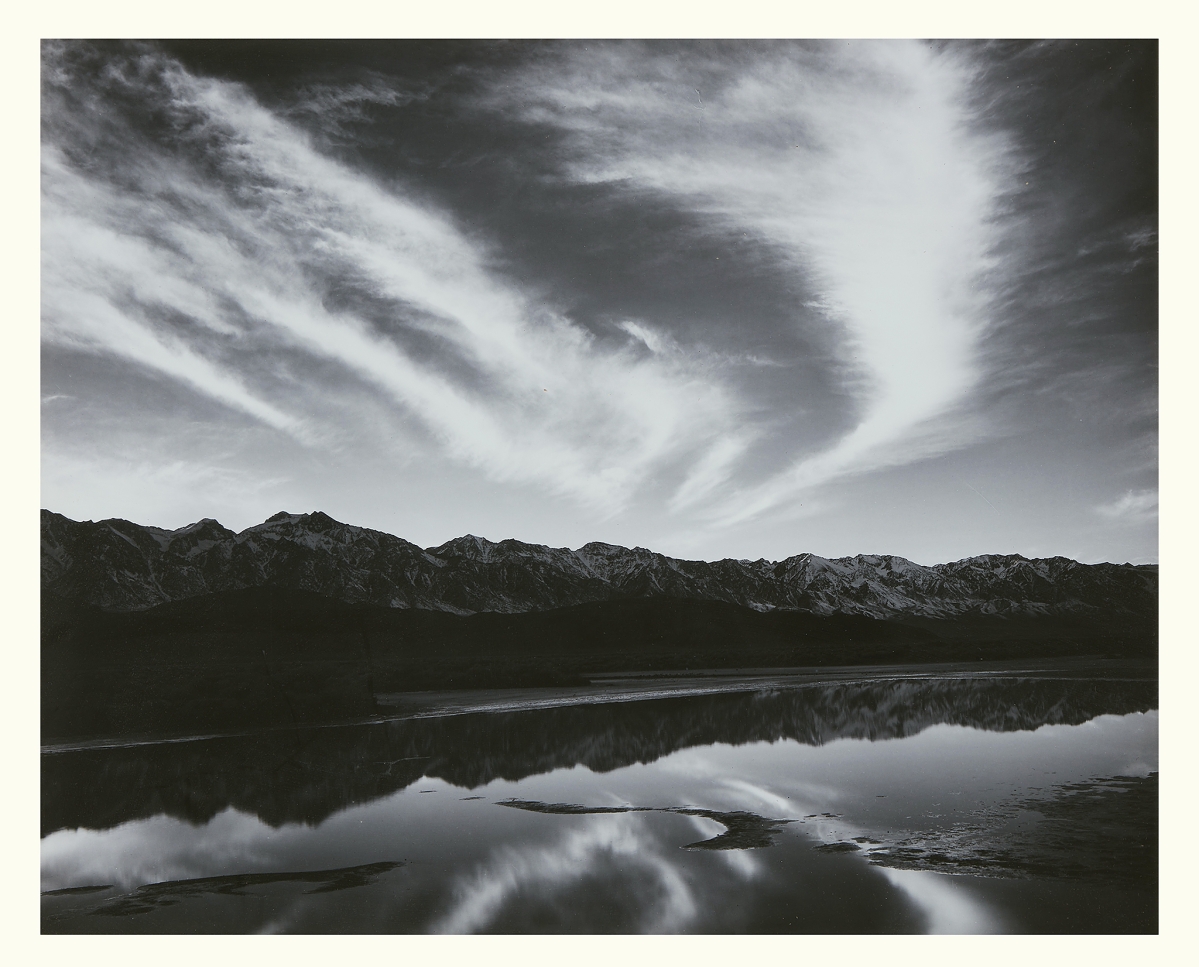
A circa 1962 gelatin silver print by Ansel Adams (1902-1984), “Evening Clouds, East Side of the Sierra Nevada, California,” once in the collection of Polaroid Corporation co-founder Dr Edwin H. Land, was bid to $10,710.
Henri Cartier-Bresson’s atmospheric gelatin silver print, “Salerno, Italy,” an example of his candid captures of quotidian street life, realized $5,040. The 1933 image, printed later, was signed by Bresson, bottom right, his blindstamp on bottom left and measured 12 by 16 inches (sheet).
More literature was in the offing, including two editions of the classic A Farewell to Arms by American novelist Ernest Hemingway (1899-1961), one finishing at $7,860 and the other earning $7,560. The Charles Scribner’s Sons, New York: 1929, first and limited edition, #383/500 copies (from a total edition of 510) was signed by Hemingway and presented in original three-quarter vellum over green paper-covered boards with black leather spine label. It was, according to catalog notes, “A fantastic copy with no discoloration to spine, and with spine label intact.” Deemed “an astounding copy” was the Charles Scribner’s Sons, 1929, first trade edition, that was in its original unclipped dust-jacket with “Katharine Barclay” instead of “Catherine Barkley” on front flap.
You can’t tell a book by its cover, the saying goes, but three pieces of cover art by Richard Chopping for Ian Fleming’s Goldfinger documented the thought and care that goes into selecting a compelling image. The artist’s own retained copy of a black and white progressive proof, circa 1959, brought $5,355. The image of skull with a rose in its teeth was signed by Chopping in pencil, lower right. The companion yellow and magenta-only color progressive proof, also signed by Chopping, sold for $5,040, and the magenta-only piece came in at $4,410.
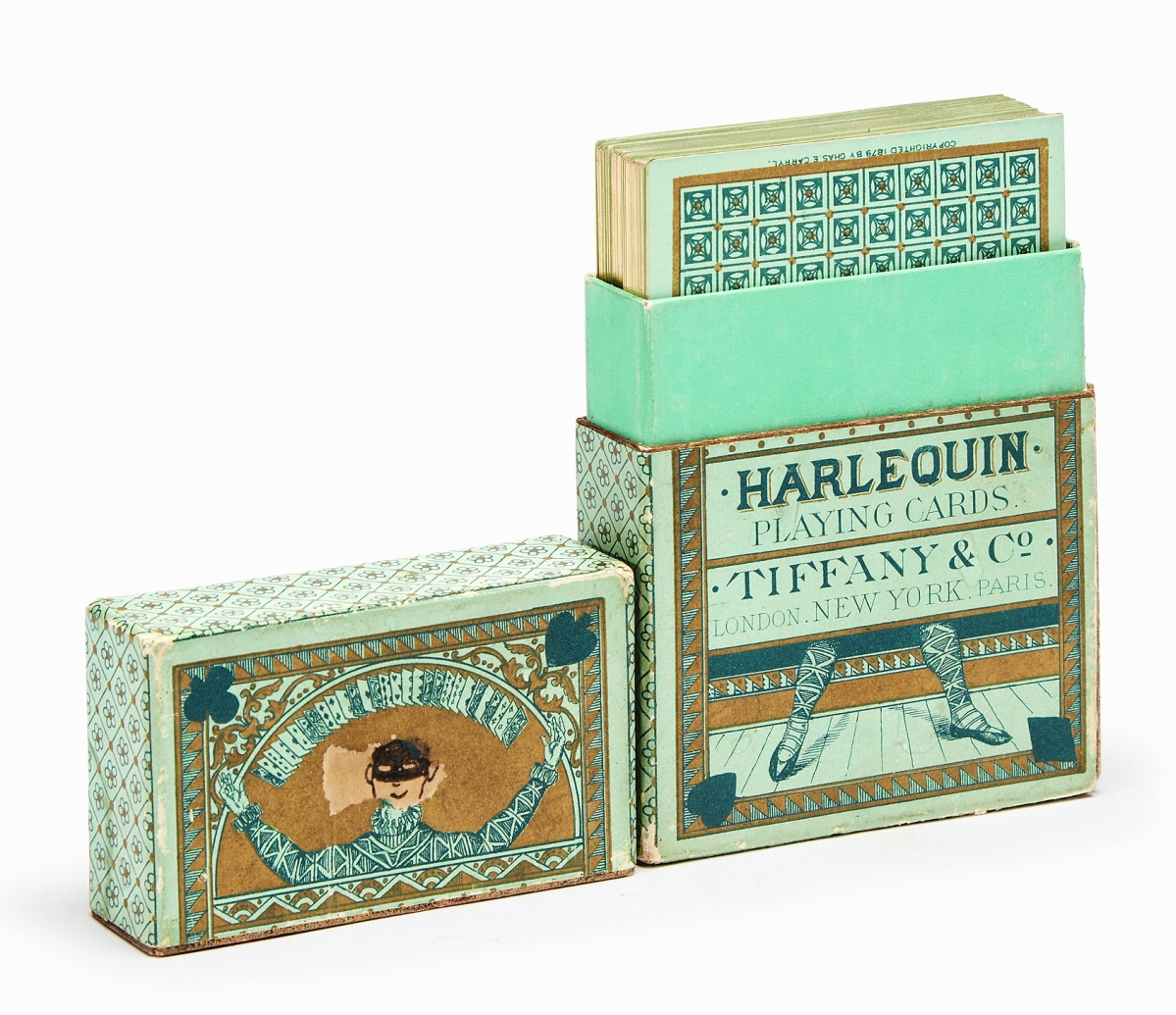
A complete deck of 52 chromolithograph transformation Harlequin playing cards, New York, Paris, London: Tiffany & Co., 1879, in their original printed box, appearing never to have been played with, was bid to $8,820, five times the high estimate.
Other highlights in the sale included presidential satire in the form of a lithographic political cartoon satirizing president Andrew Jackson and his administration’s battle with the United States Bank, “On the Way to Araby!” by Edward Williams Clay and Henry Robinson, circa 1836, making its way to $6,300 from a $400/600 estimate; a children’s literature graphite illustration by Arnold Lobel, “Frog and Toad went out to wait for the mail,” circa 1981, that made $4,095; and counter-culture’s Ralph Steadman and Hunter S. Thompson’s “Vintage Dr Gonzo,” a 1995 silkscreen, #103/500 copies, signed by Steadman and Thompson in pencil at bottom. It fetched $3,780.
The firm’s next books and manuscripts sale is set for May 20. Prices given include the buyer’s premium as stated by the auction house. For information, 215-563-9275 or www.freemansauction.com.




















